New design, new brand, same value.
By Alex Herrera
Lenovo has become an outstanding supplier of workstations, with a recent, sharpened focus on the market that makes it a serious contender for market leadership. HP and Dell dominate the space today, but despite its relatively distant third place, Lenovo has delivered an impressive growth story. The big two are now keeping an eye on the rearview mirror for the Chinese computer giant, which has recently launched a redesigned lineup, with the Thinkstation P300 as its economy-focused product offering.
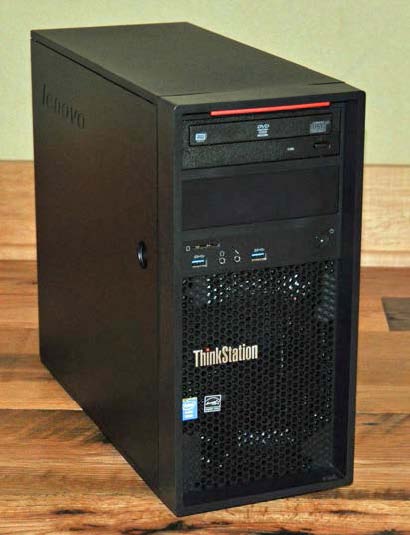
Lenovo backed into the workstation market, but it’s no bystander today
Lenovo entered the workstation market as a by-product of its acquisition of IBM’s PC business. Inheriting the ThinkPad P line in 2005, Lenovo found itself the industry leader in mobile workstations. However, it wasn’t clear the company considered workstations a strategic business until 2007, when it made a more deliberate move into the segment with a line of single- and dual-socket deskside workstations.
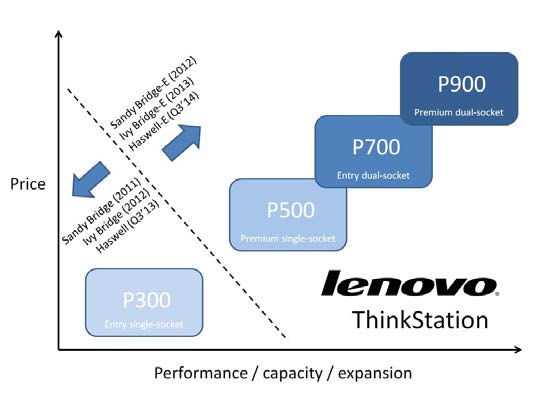
That initial workstation family— the S series (entry-level, single-socket), D series (premium-class, dual-socket), and C series (compact dual-socket)—has helped the company steadily gain market share, albeit modestly. In 2Q14, Lenovo shipped about 13.7% of the workstation units worldwide. Although more heavily slanted toward mobiles (it has about 19.1% of the worldwide mobile workstation market), its desksides are making substantial contributions to the company’s product sales.
Not counting the usual component refresh cycles, for the past few years the Thinkstation S, C, and D series remained largely unchanged since their introductions. However, with Lenovo appearing to be seriously and strategically positioning the company in the workstation market, we expected a substantial redesign (and likely some rebranding). HP made a large investment in a new, comprehensively engineered Z family of workstations in 2009. Realizing it needed to match its rival’s commitment in order to succeed in the market, Dell refocused its efforts as well with the overhauled Precision line in 2012. In 2014, it was Lenovo’s turn.
In August 2014, the company launched a new line, replacing the S, C, and D prefixes with a unified “P” prefix brand. Aligning with the industry’s de facto standard four-tier product line, Lenovo rebuilt its Thinkstation brand in two steps. First to ship was the P300, the company’s entry-level single-socket machine. The other three came later, based on Haswell-E (shipped in October). The P500 is the premium single-socket model; the P700 is the compact, economy dual-socket model; and the P900 is the top-end dual-socket machine.
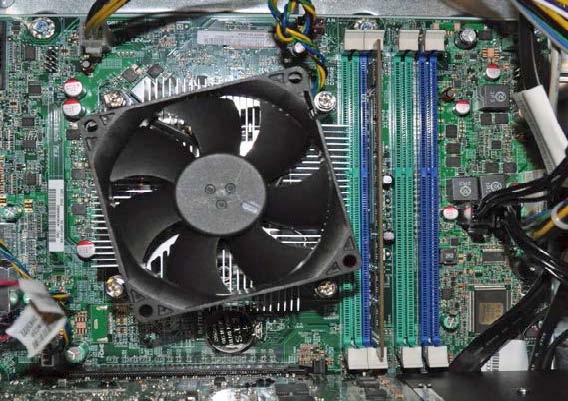
As its rivals did in their respective workstation line renaissances, Lenovo re-engineered the chassis, improving the ergonomics and cooling (and therefore noise and reliability as well). The company added the now industry-ubiquitous integrated handles, as well as color-coded “touchpoint” access points for tool-less access, addition, and removal of components, including the power supply unit (PSU).
Lenovo’s engineers reworked the workstations’ airflow via “Tri Channel” cooling, which the company claims both simplifies and enhances airflow efficiency. The Tri Channel Cooling approach allowed for fewer fans, in turn improving reliability (fewer to fail) and acoustics (fewer to contribute to noise).
Perhaps Lenovo’s most notable differentiator came in the area of slot and bay flexibility. With the new P series, the company unveiled its Flex technology, which consists of a few components designed to make available space and I/O accommodate as many different combinations of devices as possible per user requirements. A Flex Bay, for example, can accommodate not only the typical optical drive, but also an ultra-slim drive, a media card reader, or Firewire. A Flex Tray can populate both 2.5-inch and 3.5-inch drives, one of the latter or two of the former. Capable of housing seven Flex trays, the P900 can support 14 drives.
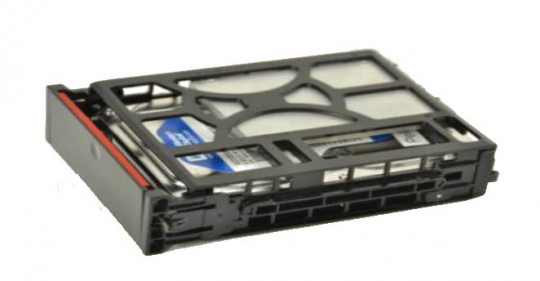
A third component, the Flex Connector, is an optional “mezzanine” daughter card that can sit directly on the motherboard to provide SATA, SAS, or PCIe storage without occupying PCIe slots.
Some workstations are built for all-out performance and all-out expansion, while others are built to deliver the workstation basics—reliability with an application-optimized performance boost—at the minimum cost. Lenovo’s take on the latter model is the Thinkstation P300, a machine that starts at $729. Our review model was of a conventional mini-tower, but the P300 comes in a small form factor version as well.
Despite its attention to economy, the P300 can certainly be configured to crank professional-grade performance. It supports a range of Core i7 and Core E3 Haswell-class CPUs, up to 32 GB of memory, and up to four bays of storage that max capacity at 16 TB. Graphics capabilities come courtesy of an Nvidia Quadro add-in card, with Haswell’s integrated GPU as a minimal-cost option.
With its signature honeycomb grill, the P300 exterior shares the same look-and-feel as the rest of the new P-series family. Paying attention to costs, the P300 has a no-frills interior, but that doesn’t mean it feels cheap. On the contrary, the interior is neat and accessible, and we liked the trade-offs Lenovo made in delivering tool-less access without being flimsy.
Tool-less is now a check-mark item for workstations, and the P300 complies, with blue-coded tabs to guide fingers looking to open panels, release cards, and swap bays. In particular, we valued the squeeze-to-release end tab on the PCI Express slot, which was both simple and solid.
We also preferred Lenovo’s GPU card retention system over most. Rather than relying on plastic, slide-in retention for the end of the card, Lenovo has a fixed metal bracket that attaches securely to the card via two thumb screws. We move around our machines a lot, and GPU cards—particularly the heavy, high-end, dual-slot variety—are the easiest components to displace.
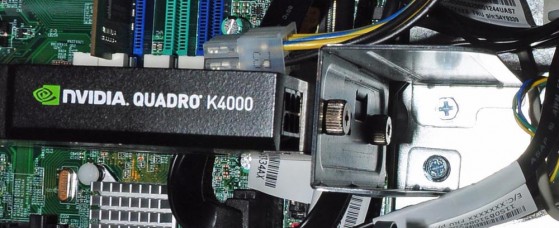
As with its predecessor, the Thinkstation E32, the P300 comes with an 85% efficient power supply, rated for 280 watts. There is a more efficient (92%) and more powerful 450-watt supply option.
The P300’s I/O options is unlikely to disappoint, providing four USB 3.0, two USB 2.0 in the rear, one eSATA, one Ethernet, and the standard analog audio ports. The only omission worth noting is Thunderbolt, but its appeal is still limited in most workstation applications (as opposed to the Mac space, where it is essential). The rear panel also includes a legacy VGA and two modern DisplayPort video interfaces to support the Haswell CPU’s on-board GPU.
Benchmarking the P300
While the P300 can be configured with components to push its actual price well in excess of its advertised starting-at price, ours came outfitted with upgrades that pushed it to a selling price of $2,068, a figure that sits pretty much squarely at the market’s current ASP. First and foremost among up a Kepler generation card paired with 3 GB. Selling at retail at around $900, the K4000 is responsible for a healthy chunk of the P300’s price tag.
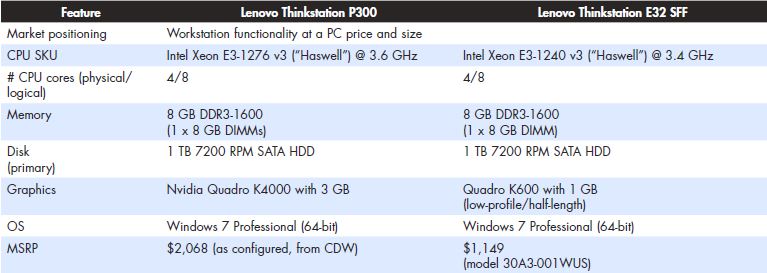
An ideal comparison machine for us is the P300’s predecessor, the Thinkstation E32, a machine we reviewed earlier in 2014 in a small form factor version.

With the exception of the GPU, the two machines are configured very similarly, with the only other notable difference being the P300’s slightly faster CPU. The pair make good test cases to assess how much difference the more capable GPU can make, given the price adder.
We tested both machines with SPEC. org’s SPECwpc benchmark suite. SPECwpc’s whole-system testing gives a clearer idea of how the fully configured system will perform, considering the entire workload, including application, graphics, memory, OS, I/O, etc. It’s designed to be comprehensive, comprising separate suites, one per each of six verticals, including Media and Entertainment, Product Development, Energy, Life Sciences, Financial Services, and General Operations. Each suite includes anywhere from five to nine workloads, relevant to those specific spaces. The new benchmark reports a composite score, aggregating sub-test results, for each of the six application suites.
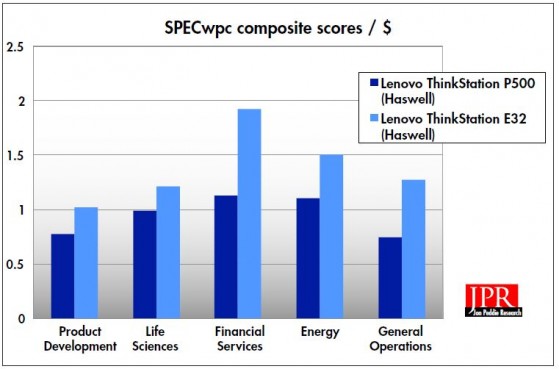
Not surprisingly, the Quadro K4000–equipped P300 tops the E32 with a more modest K600 GPU on five of the six composite scores, but the degree of superiority varies by workload. We couldn’t compare composites on the Media and Entertainment suite because the E32’s initial testing failed on one component (Handbrake). The two workstations performed similarly on the rest of the Media and Entertainment components, with the notable and expected exception of Maya, which is especially GPU sensitive.
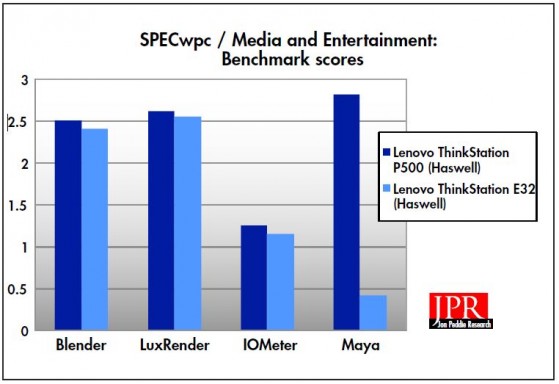
With specs at least on par with the E32’s, and with a vastly superior GPU, the P300 shouldn’t lose out on raw scores. And it doesn’t. But what’s often more interesting, particularly in the economy-focused end of the market, is how the performance scales with incremental dollars. How well does the P300’s higher build cost—the bulk of which is attributable to the K4000 GPU —provide a return in the form of higher performance? The composite and Media and Entertainment scores give an indication.
As we’d expect, price/performance favors the lower-cost machine, a typical and sensible result that reflects diminishing returns as the price climbs. The exception, once again, is in running the Maya workload, which heavily depends on GPU throughput and benefits from the far superior K4000.
In the JPR Workstation Report, we include the rest of the suites’ sub-test results, both raw scores and scores/$. Though the degree varies by application space and sub-test, the results track the overall composites, with the Boxx leading in absolute score and the Lenovo E32 leading in scores per dollar.

What do we think?
Whether it originally entered the market by intent or not, the company has learned what it takes to compete. As evidence, we’re seeing Lenovo up its interest and investment in comprehensive engineering and marketing, to keep up with primary competitors, Dell and HP. It knew it needed to match the market leaders’ level of commitment, and with the recent launch of the new Thinkstation P series, it has.
The new P series integrates the same core components from Intel and Nvidia that its rivals rely on. And it’s made many of the same enhancements to the chassis design, like optimal cooling, ergonomics, and minimal noise. Plus, it’s taken its own slant in a few areas, like tool-less access. In terms of well-thought-out, well-engineered design, the P series holds its own.
In the benchmarking of the Thinkstation P300—and particularly in contrast with the previous testing of its predecessor, the Thinkstation E32—we reached these conclusions:
- With a similar configuration, the P300 can compete head-on with its rivals’ comparable offerings, most notably HP’s Z230 and Dell’s Precision T1700.
- A machine that is “entry” in name, like Lenovo’s Thinkstation P300, can be capably equipped, yielding exceptional performance if so desired.
- Where those capabilities climb, however, the price climbs with it, and performance usually scales with diminishing returns.
- For professional workloads stressing the visualization of big, complex 3D models, the GPU is one of the best places to spend extra dollars.
Lenovo is a workstation newbie no longer. Like HP and Dell, Lenovo is now “all-in” on workstations, and this latest, comprehensive refresh of its Thinkstation line shows it. Its market share is climbing, and both the company and its products should continue to grow as a force in the market.





